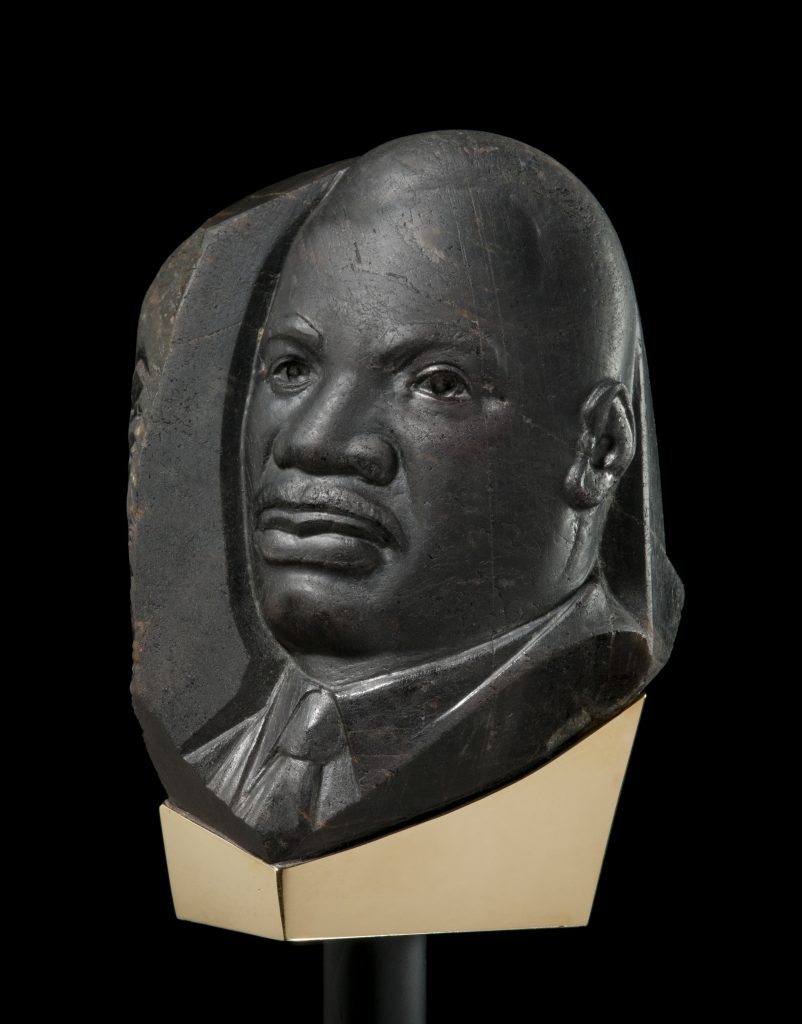Martin Luther King Jr., in Sapphire
There are many ways to memorialize the immortal Reverend Martin Luther King Jr., the most famous and important civil rights leader of our time. Many, if not most, American cities have a street named after him. Scores of schools and buildings carry his name. Many parks and civic institutions have erected statues and monuments in his honor—such as a bronze statue recently raised in Denver’s City Park, near my home and the museum I work in. But perhaps the world’s most unique sculptural tribute to the great civil rights crusader is Vasily Konovalenko’s Martin Luther King in Sapphire.
The late Soviet artist Vasily Konovalenko worked as a set designer at the Mariinsky Theatre in St. Petersburg, Russia, in the 1950s. For a ballet called The Stone Flower, Konovalenko had to carve a stage prop out of malachite, a beautiful, banded, copper-rich, green and black mineral. In so doing, Konovalenko fell in love with the art of gem carving. Over the next four decades and until his untimely death in 1989, Konovalenko created more than 70 wonderful gem-carving sculptures, some of which are now on display at the Denver Museum of Nature & Science and the State Gems Museum in Moscow.
In the mid-1940s, Kazanjian Brothers, a company in Beverly Hills, California, that dealt in diamonds, acquired the largest black sapphire known to humankind—a 4,180 carat behemoth (about the size of an average man’s fist) excavated in Western Australia. In the early 1980s, Michael Kazanjian commissioned Konovalenko to carve Martin Luther King Jr.’s bust in that sapphire. Konovalenko set to work, but the challenge was immense.
Sapphire is second only to diamond on the Mohs hardness scale. Although a distant second, sapphire is one of the two hardest substances in the known universe. It is far harder than the vast majority of stones Konovalenko had experience working with, such as agate, jasper, obsidian, and quartz, which are plenty hard. Although Konovalenko had cut and faceted sapphires to make eyes for his sculptures, these were standard gem cutting-and-polishing operations on very small blue sapphires. As any gem carver will tell you, cutting straight lines on small pieces is relatively easy. Carving curved surfaces on large pieces requires the touch of a master.
Konovalenko also had to carve the distinctive curves and features of a well-known luminary’s face. He could therefore be “wrong” in his effort; there is little room for artistic license when anatomical precision is demanded. Complicating matters further, Konovalenko could not correct mistakes if he carved too deeply, and he could not start over because he had only one stone with which to work. And it just happened to be the most valuable sapphire in the world.
Finally, gem carving is what archaeologists refer to as a “reductive” technology, in which raw material is removed in order to produce the final, desired product. Reductive technologies are contrasted with “additive” ones, like sculpting in clay, in which raw materials can be added during the course of manufacture. Everything else being equal, it is easier to correct mistakes in additive technologies than in reductive ones. Imagine the pressure Konovalenko must have felt as he carved the world’s largest black sapphire, with the chance of being wrong, and no easy way to correct mistakes. Carve too little and the image would be incomplete. Carve too much and the image is destroyed.
Although his final product was by no means perfect, Konovalenko succeeded admirably in producing Martin Luther King in Sapphire. He included subtle but distinctive details including King’s pencil-thin mustache, neatly cropped hairline, and well-groomed eyebrows. The face has a serious, contemplative disposition, as if preparing to give another memorable speech. Konovalenko removed 886 carats (21 percent) from the stone to make the sculpture, and in so doing created a unique memorial to a remarkable human being.
Correction: February 7, 2023
An earlier version of this article referred to Konovalenko as a Russian artist rather than a Soviet artist.


























